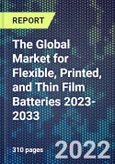Demand for advanced batteries has increased greatly in recent years and the market for Flexible, Printed, and Solid-State Thin Film batteries will explode in the next decade in Internet of Things (IoT), wearables, flexible electronics, sensors and electric vehicle applications.
Given the increasing demands for flexible and wearable electronics, it is necessary to develop corresponding energy storage devices that are mechanically flexible, foldable and even stretchable. These emerging energy storage devices also need to be lightweight and have high electrochemical performance with a high energy density, high rate capability, and long cycling life.
Mass manufacturing of solid-state batteries, while in its infancy, will have a huge impact on the market for electric vehicles, allowing for enhanced safety, range and performance. As well as requiring characteristics such as low cost and high energy density and power density, battery requirements for new technologies include:
- small footprint (conventional batteries take up to 40% of the space of wearables and mobile phones)
- flexibility
- various form factors
- shape conformability
- easy integration with devices.
The Global Market for Flexible, Printed, and Thin Film Batteries 2023-2033 covers all the latest developments, key player activities, end user market applications and current and future trends.
Report content includes:
- State of market and technology developments for Flexible, Printed, and Solid-State Thin Film batteries, applications, future trends & opportunities and global players products and activities.
- Technologies covered include printed batteries, solid-state batteries, thin-film lithium batteries, 2D and 3D Micro-batteries, carbon-zinc batteries, stretchable batteries, rollable batteries, Fiber-shaped lithium-ion batteries, foldable batteries, cable-shaped batteries, thin flexible supercapacitors, transparent batteries.
- Global revenues by battery types and markets 2020-2033.
- Markets covered include wearables, electronic textiles, medical devices, diagnostics, implantables and skin patches, cosmetic, portable electronics, internet of things wireless sensor and connected device, radio-frequency identification (RFID) tags, smart cards, and smart labels for food packaging, supply-chain logistics etc.
- 124 in depth company profiles. Companies profiled include Addionics, Ateios Systems, Blackstone Resources AG, Blue Solutions, Blue Spark Technologies, Inc., Britishvolt, Factorial Energy, Ilika, ProLogium, QuantumScape, Sakuu, Solid Power, and Sparkz.
This product will be delivered within 1-3 business days.
Table of Contents
Companies Mentioned (Partial List)
A selection of companies mentioned in this report includes, but is not limited to:
- 24M Technologies, Inc.
- 3DOM Inc.
- AC Biode
- Addionics
- AirMembrane Corporation
- Ambri
- Ampcera, Inc.
- Amprius, Inc.
- Anaphite Limited
- Anthro Energy
- APB Corporation
- Ateios Systems
- Australian Advanced Materials
- AZUL Energy Co., Ltd
- Black Diamond Structures, LLC
- Blackstone Resources
- Blue Current, Inc.
- Blue Solutions
- Blue Spark Technologies, Inc.
- Bodi, Inc.
- BrightVolt, Inc.
- Britishvolt
- CellsX
- CENS Materials Ltd.
- Connexx Systems Corp
- Cymbet
- Dotz Nano
- Dreamweaver International
- E-Magy
- Enfucell Oy
- Ensurge Micropower ASA
- Factorial Energy
- FDK Corporation
- FlexEnergy LLC
- Forge Nano, Inc.
- Fraunhofer Institute for Electronic Nano Systems (ENAS)
- Front Edge Technology
- Fuelium
- Fuji Pigment Co., Ltd.
- Fujitsu Laboratories Ltd.
- Ganfeng Lithium
- Gelion Technologies Pty Ltd.
- Global Graphene Group
- General Motors (GM)
- GQenergy srl
- Grafoid
- Graphene Batteries AS
- Graphene Manufacturing Group Pty Ltd
- Shenzhen Grepow Battery Co., Ltd. (Grepow)
- Group14 Technologies, Inc.
- Corporation Guangzhou Automobile New Energy (GAC)
- Hansol Chemical
- HE3DA Ltd.
- Hexalayer LLC
- Hitachi Zosen Corporation
- HPQ Nano Silicon Powders Inc.
- Hybrid Kinetic Group
- Idemitsu Kosan Co., Ltd.
- Ilika plc
- Imprint Energy, Inc.
- InnovationLab
- Intecells
- Ionic Materials
- Ion Storage Systems LLC
- I-Ten SA
- Jenax, Inc.
- Johnson Energy Storage, Inc.
- Johnson Matthey
- LG Chemical, Ltd.
- LiBest, Inc.
- LiCAP Technologies, Inc.
- Lionrock Batteries
- LionVolt BV
- Lithium Werks BV
- Lyten, Inc.
- Merck & Co., Inc.
- Murata Manufacturing Co., Ltd.
- NanoGraf Corporation
- Nanom
- Nanoramic Laboratories
- Nano One Materials
- Nanotech Energy Inc.
- Nawa Techonologies
- NDB
- NEC Corporation
- NEI Corporation
- NGK Insulators Ltd.
- Nimbus Materials, Inc.
- Nippon Chemicon
- OneD Material
- PJP Eye Ltd.
- PolyPlus Battery Company
- Power Textiles Limited
- prelonic technologies
- Prieto Battery
- Printed Energy Pty Ltd.
- Prologium Technology Co., Ltd.
- Qing Tao Energy Development
- QuantumScape Battery Corporation
- Sakuú Corporation
- SaltX Technology AB
- Samsung SDI
- Saratoga Energy Corporation
- Semiconductor Energy Laboratory Co., Ltd.
- SES
- Sicona Battery Technologies Pty Ltd
- Sila Nanotechnologies
- Silatronix
- Sionic Energy
- Soelect, Inc.
- Solid Power Inc.
- Sparkz, Inc.
- StoreDot
- STMicroelectronics
- TDK
- Tentok Paper Co. Ltd
- TeraWatt Technology
- Toray Industries
- Tokushu Tokai Paper Co., Ltd.
- Ulvac
- UNIGRID Battery
- Urbix Resources
- Vaulta
- Volexion








